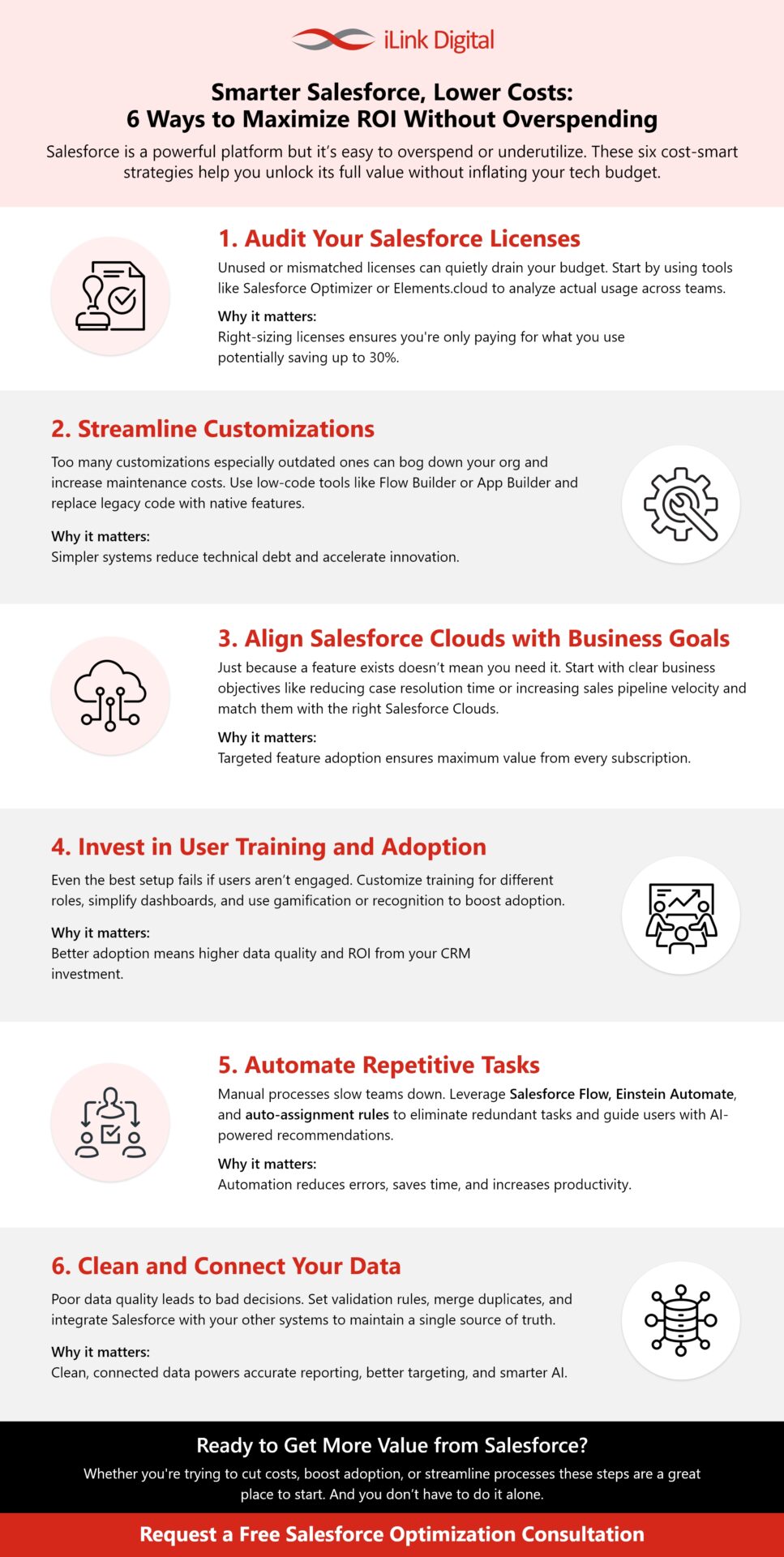How to Optimize Your Salesforce Cloud Without Burning Budget?
You’re Paying Enterprise Pricing—But Using Basic Features
Salesforce has become a cornerstone for enterprise CRM strategy, yet many companies fall into the trap of using it like a basic contact database. The platform’s promise of data-driven customer engagement, streamlined sales pipelines, and intelligent automation often goes unrealized. This happens not because Salesforce lacks capability—but because teams lack the time, resources, or strategic clarity to optimize how it’s used.
At a time when cloud spending is under the microscope and digital ROI is being closely monitored, simply maintaining the status quo with Salesforce could mean leaving money—and value—on the table.
Optimizing Salesforce isn’t about cutting corners—it’s about unlocking value.
This blog explores practical, research-backed steps to help you make the most of Salesforce boosting performance and outcomes while keeping your investment in check.
Why Salesforce Optimization Should Be on Your Radar
Salesforce is integral to managing customer relationships, sales operations, and service delivery. However, without a targeted optimization strategy, it risks becoming a cost center rather than a driver of business growth.
Organizations commonly face several challenges:
- Rising cloud costs amid tighter IT budgets
- Increased scrutiny from finance teams to demonstrate value from every SaaS investment
- Complex environments with overlapping licenses and fragmented configurations
- A Forrester study found that aligning your Salesforce setup with business goals can boost ROI by as much as 40%.
- Meanwhile, 82% of enterprises rank cost control as their top cloud challenge according to Flexera’s 2024 State of Cloud Report.
The takeaway is clear: optimizing your Salesforce environment not only reduces costs but also strengthens your return on investment. The more strategically you use Salesforce, the greater the business value you can unlock.
6 Strategies to Get More From Salesforce—Without Overspending
- Run a Salesforce License Audit
According to Gartner, organizations waste more than 30% of their software spending on unused or rarely used licenses—Salesforce is no exception.
To optimize costs, begin by thoroughly reviewing your current Salesforce license usage. Many organizations inadvertently overspend by assigning higher-tier licenses to users who do not require full access, or by retaining licenses that are no longer in use.
Consider the following steps for an effective audit:
- Use Salesforce Optimizer or third-party tools such as Elements.cloud to identify inefficiencies.
- Align license types with users’ actual roles and responsibilities.
- Deactivate unused accounts before renewal periods.
Right-sizing licenses alone can cut costs by up to 30%, according to Salesforce Ben. This approach not only controls expenses but also ensures that resources are allocated efficiently across your teams.
- Simplify Customizations
While customization can enhance Salesforce’s effectiveness, excessive or outdated customizations often lead to unnecessary complexity and technical debt. Focus on streamlining your environment:
- Leverage no-code tools like Salesforce Flow or App Builder for flexible, low-maintenance solutions.
- Replace legacy customizations with out-of-the-box features introduced in recent Salesforce releases.
- Utilize trusted AppExchange solutions to address common needs efficiently and cost-effectively.
Simplifying customizations reduces development time, improves system stability, and accelerates upgrades.
- Align Salesforce Clouds with Your Business Objectives
Each Salesforce Cloud offers specialized capabilities, but not every solution is necessary for every organization4. A strategic approach helps prevent tool sprawl and keeps costs under control.
- Clearly define business priorities—such as shortening sales cycles, improving service response times, or increasing customer engagement.
- Map each objective to the most relevant Salesforce features or Clouds.
- Implement new features or Clouds in phases, monitoring ROI at each stage.
This ensures that every Salesforce investment is directly tied to measurable business outcomes
- Invest in User Adoption and Training
Sales reps, on average, spend just 18% of their time using CRM tools, highlighting a widespread underutilization issue.
Even a perfectly configured Salesforce org won’t deliver value if users aren’t confident using it. Adoption is one of the most overlooked—but impactful—ways to improve your CRM ROI.
- Tailor training to specific roles and departments
- Streamline dashboards and forms to reduce friction
- Encourage participation through gamification or internal recognition programs
- Automate Repetitive Work
Automation tools within Salesforce often go underused. When applied correctly, they can streamline key workflows and free up time for high-value work.
- Use Salesforce Flow to automate lead assignments, approvals, and email follow-ups
- Tap into Salesforce Einstein to guide reps with predictive scoring and next-best actions
- Modernize outdated workflows and consolidate them into clear, repeatable processes
These tools can reduce administrative burden and help teams act faster with greater precision.
- Keep Your Data Clean and Connected
Data quality is foundational to effective CRM operations. A Harvard Business Review study found that bad data can cost companies between 15% to 25% of their revenue, making strong data hygiene a critical investment.
- Implement validation rules and automation to ensure data accuracy at the point of entry.
- Conduct regular audits to identify and resolve duplicates, outdated contacts, and data gaps.
- Integrate Salesforce with other business platforms to create a unified and reliable data source.

Gartner estimates that poor data quality costs organizations $12.9 million on average each year. Strong data hygiene supports better decision-making, more effective automation, and maximizes the value of AI-driven insights.
How iLink Helps You Optimize Salesforce Cloud—End-to-End
At iLink Digital, we take a structured and personalized approach to Salesforce Cloud Optimization. Our strategy focuses on delivering value at every phase of your Salesforce journey—from initial setup to long-term performance tuning.
Here’s how we do it:
- Requirements-Led Discovery: We begin by understanding your business goals and Salesforce pain points, ensuring our recommendations support measurable outcomes.
- Full-Lifecycle Optimization: From setup and configuration to automation, user adoption, and ongoing support—we provide continuous enhancements, not one-time fixes.
- Cloud Alignment: Whether you use Sales Cloud, Service Cloud, or both, we tailor features to fit your process—not the other way around.
- Post-Launch ROI Tuning: Once live, we track usage, identify gaps, and refine configurations to ensure your Salesforce environment evolves with your needs.
We don’t believe in over-engineering. Our goal is to help you simplify, streamline, and succeed—without wasting time or resources.
Final Thoughts: Make Every Salesforce Dollar Work Harder
Optimizing your Salesforce environment isn’t about doing more with less—it’s about doing more with what you already have. Through smarter licensing, cleaner processes, stronger user engagement, and better data, organizations can unlock real value without expanding their footprint.
At iLink Digital, we help businesses:
- Audit and optimize Salesforce usage and spend
- Establish Centers of Excellence to improve governance
- Create roadmaps that align Salesforce capabilities with real business goals
Ready to get more out of Salesforce?
Reach out today to schedule a free Salesforce Optimization Assessment—and start transforming your CRM from a sunk cost into a growth enabler.


